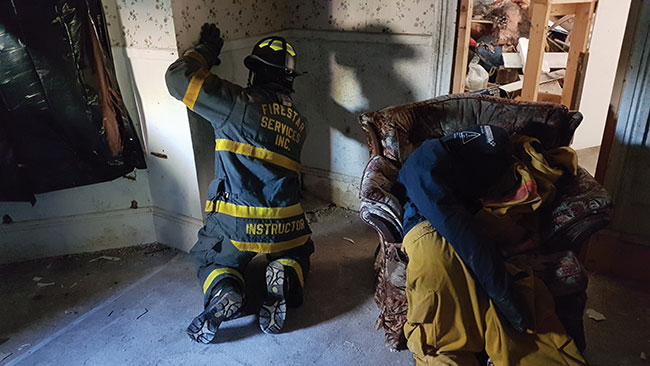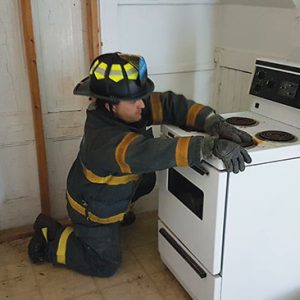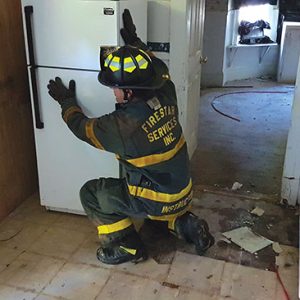
Features
Structural
Training
Back to Basics: Primary search — focus on the floor
November 4, 2021
By Mark van der Feyst
 Photo 1: Here is an example of the wall patter, a common search done by some firefighters. Mistakenly, search team can waste their time by feeling up the wall instead of focusing on the floor – the wall is not where we are going to locate occupants.
Photos by Mark van der Feyst
Photo 1: Here is an example of the wall patter, a common search done by some firefighters. Mistakenly, search team can waste their time by feeling up the wall instead of focusing on the floor – the wall is not where we are going to locate occupants.
Photos by Mark van der Feyst
One of the basic fire ground operations that is completed at every structure fire is a search. The search is where we address the life safety priority on the fire scene for the occupants of the structure. Within the search operation, we have a primary and secondary search that is to be completed before we can declare an “all clear” for the entire structure.
The primary search is going to be conducted first with the secondary search being done to follow up the primary search. As basic as this may sound and as simple as it may seem for understanding, it is good to differentiate between the two so that the operation for each is carried out as required.
The primary search is an organized search but with the focus being on key areas where occupants will be found commonly when trying to escape. It is a quick search racing against time – time of the fire growing in size and the time available for the occupants to survive being exposed to the toxic effects of the smoke and unburned particles of combustion. The quicker they are found, the quicker they will be removed from the environment and have access to medical attention. The secondary search is a much slower search where time is not a factor. This type of search is looking at every spot in the building to ensure that no one was missed during the primary search.
Our focus is going to be on the primary search and more importantly on the floor of the structure. The floor is where we are going to find our occupants with the exception of the bed (including bunk beds) and bathtub. The common locations of where we are going to find our occupants in a structure fire will be at the fire location, exit points such as at the window, doors, hallway, stairs, and based on time of day, in their beds.
With knowing these common locations, when an occupant succumbs to the effects of the products of combustion, they are going to fall on the floor – this is where we are going to find them the majority of the time. So, in light if this, we need to cater the search to always focus on the floor for the search firefighter. The lead firefighter will focus on building orientation and leading the search on.
In Photo 1, we see an example of the common search conducted by some firefighters – the wall patter. The lead firefighter as mentioned needs to maintain building orientation and to do this will need to have one hand on the wall with the other hand on the haligan to lead. The one hand on the wall will be sweeping the wall high and low. The search firefighter will be searching off the lead firefighter and will need to focus on the floor. Photo 1 shows how a search team can waste their time by feeling up the wall instead of focusing on the floor – the wall is not where we are going to locate occupants.
In Photo 2 we see another example of a common search mistake – searching on top of furniture and/or appliances. Many firefighters when they encounter an appliance or a piece of furniture like a table or side table, they feel the need to search the top of it. As mentioned previously, we are fighting against time when doing a primary search and taking the time to search or sweep the top of the table or the stove is a waste of time. It is not just a sweep that occurs usually, but rather a patting and feeling around on top of the appliance and furniture. Much time is wasted by “feeling” or “patting” the tops of appliances and tables. The occupants inside the structure are not going to be on top of the stove or table, they are going to be on the floor.
Photo 3 shows another example of a common search mistake – searching in and around appliances and furniture. In this syndrome, the search firefighter takes the time to search behind the appliance or piece of furniture like a sofa, the sides of the appliance or furniture where it rests against a wall and in the case of the fridge, search up it to the top. Searching around the appliance on the floor area in front of it is where we want to focus – it is on the floor area that we will locate the occupant. As mentioned in the previous point, much time is wasted searching behind – occupants will not be located behind a fridge or a sofa unless they are put there on purpose, and this would constitute a crime scene.
The only time that a search firefighter will search up a piece of furniture is when they are in a bedroom and feel the legs of a bunk bed or when in the bedroom, feel no bed present. This should clue in the search firefighter that there is a bunk bed and that needs to be swept on top to ensure no one is present. The same is to be done with a normal bed or sofa couch – sweep the top in one pass to ensure no one is present. Do not take to much time to “pat” the top of the bed or sofa.
To help curtail these practices and to develop the proper practice of focusing on the floor, training is what is needed. Practice on a regular basis is what will help to build the muscle memory to focus on the floor. Any access to an acquired structure or a fixed facility will work – just make sure to transform it into a real search environment with realistic furnishings and items on the floor like carpet or clothes on the floor.
Mark van der Feyst has been in the fire service since 1999 and is currently a firefighter with the FGFD. He is an international instructor teaching in Canada, the United States, FDIC and India. He is a local level suppression instructor for the Pennsylvania State Fire Academy and the lead author of Fire Engineering’s Residential Fire Rescue book and other DVDs. He can be contacted at Mark@FireStarTraining.com.
Print this page

